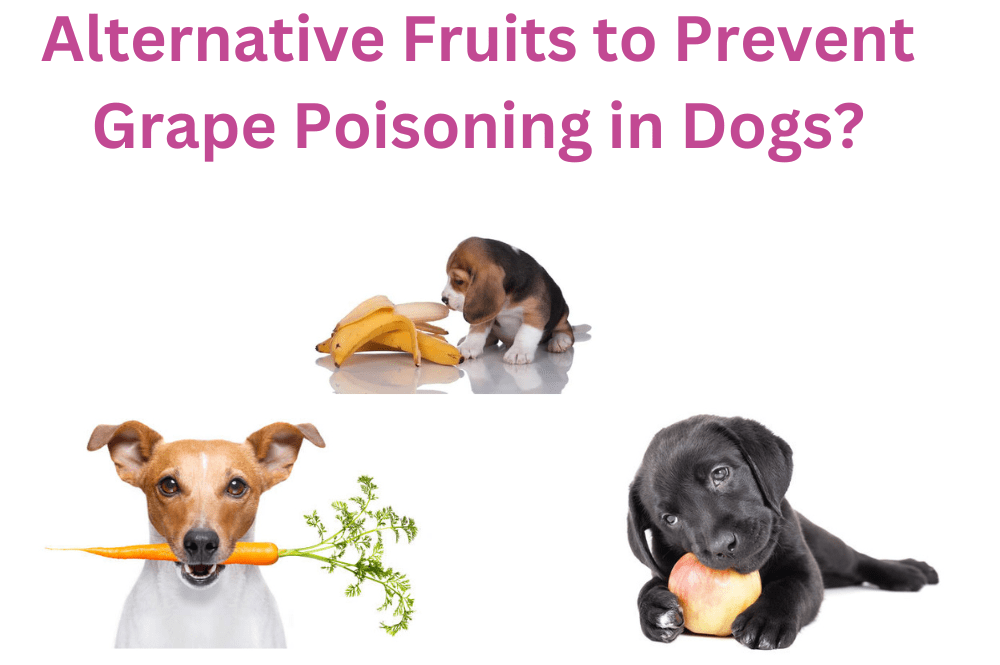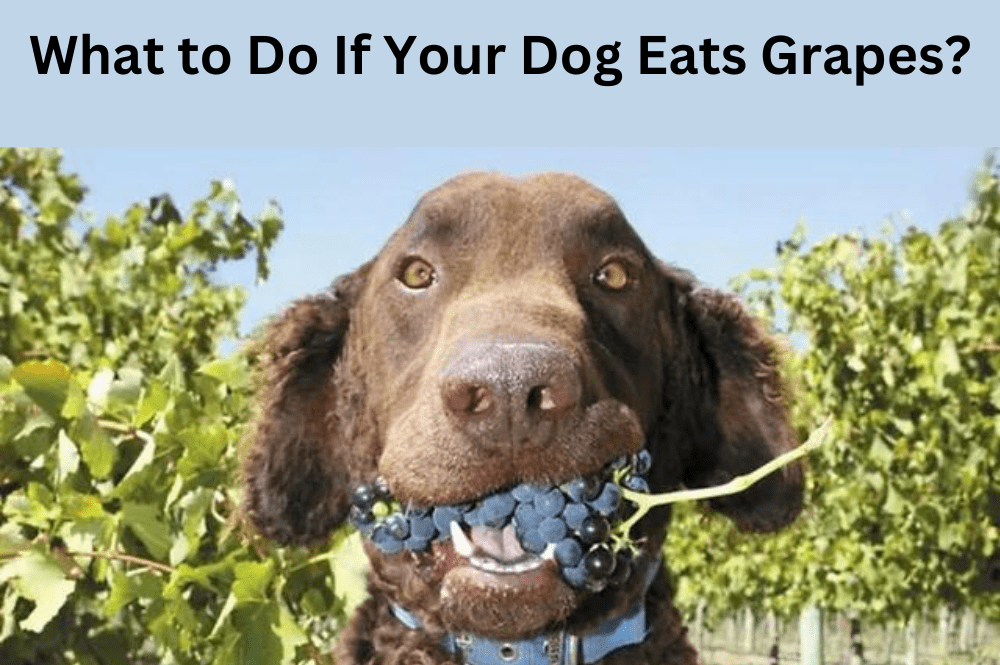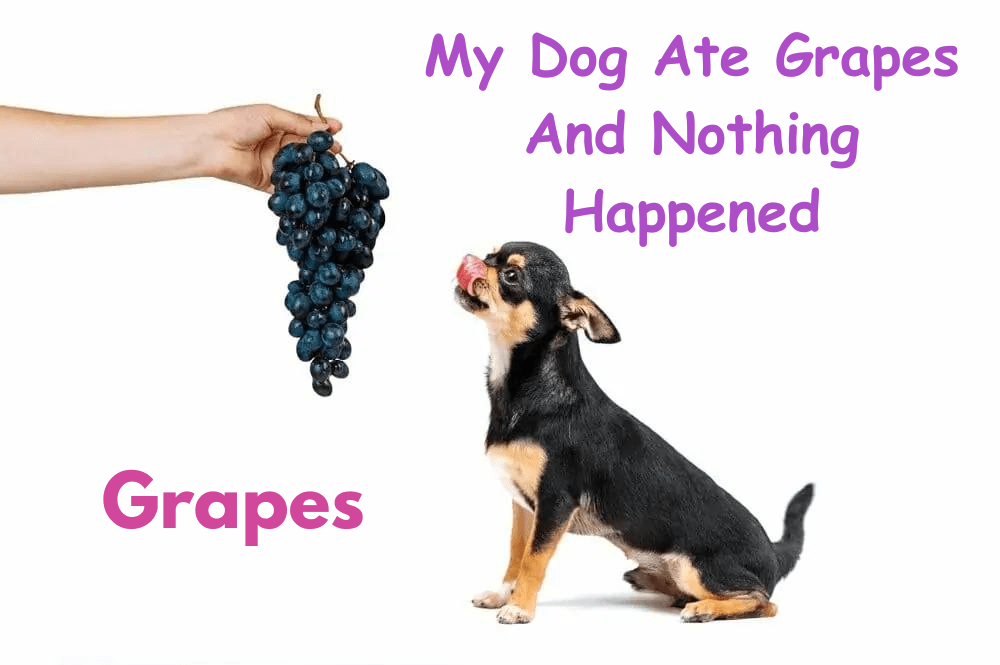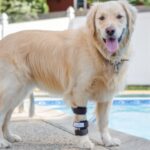My Dog Ate Grapes and Nothing Happened, sometimes you see the opposite results. Have you ever heard that rapes are toxic for dogs? I didn’t, until one day I found my dog, Max, munching on a bunch of grapes that I had left on the kitchen counter.
I panicked and searched online for what to do. I learned that grapes can cause acute kidney failure in dogs and that the symptoms can include vomiting, diarrhea, lethargy, dehydration, and even death. I was terrified and rushed Max to the vet, hoping he would be okay.
In this article, I want to share my experience and provide some useful information on how to prevent and deal with dog grape poisoning. I hope this will help you avoid my mistake and keep your furry friend safe and healthy.
Contents
Why Are Grapes Bad for Dogs?
The exact reason why grapes are toxic for dogs is still unknown, but scientists believe that it has something to do with a compound in the grapes that damages the kidneys of dogs. According to a study by the Animal Poison Control Center, grapes and raisins are the most common cause of kidney failure in dogs. The study also found that the toxicity is not dose-dependent, meaning that even a small amount of grapes can be harmful for some dogs.
Some factors that may influence the severity of grape poisoning are the amount of grapes, the size and breed of the dog, and the individual sensitivity of the dog. However, there is no safe amount of grapes for dogs, and any ingestion can be potentially fatal. Therefore, do not believe that my dog ate grapes and nothing Happens because it does not happen every time. It is best to avoid giving grapes to your dog at all costs.
How to Prevent Grape Poisoning in Dogs?
The best way to prevent grape poisoning in dogs is to keep grapes away from your dog. Here are some practical tips on how to do that:

- Store grapes in a high or locked place, such as a fridge, a cabinet, or a drawer, where your dog can’t reach them.
- Don’t leave grapes on the table or counter, where your dog can easily jump and grab them.
- Don’t share grapes with your dog as a snack or a treat, even if he begs or looks cute. Remember, grapes are not good for him, and he doesn’t know that.
- Give your dog some alternative fruits or treats that are safe and healthy for him, such as apples, bananas, carrots, or peanut butter. Make sure to wash and cut the fruits into small pieces, and remove any seeds or cores.
- Always check the ingredients of any food or product you give to your dog, as some may contain grapes or raisins, such as trail mix, granola bars, or baked goods. Read the labels carefully and look for any signs of grape or raisin content, such as “dried fruit”, sultanas, or currants.
- Educate your family and friends on the dangers of grapes for dogs, and ask them not to feed your dog any grapes or raisins, or leave them within his reach.
Suggested: Can Dogs Have Cream Cheese Icing?
Does Chicken and Rice Cause Constipation In Dogs?
What to Do If Your Dog Eats Grapes?
If your dog eats grapes, you need to act quickly and call your veterinarian or a pet poison helpline as soon as you notice or suspect that he has eaten grapes. The sooner you get help, the better the chances of saving your dog’s life.
Here is what information you need to provide to the vet or the helpline:
- The amount and type of grapes your dog ate, such as fresh, dried, seedless, or seeded. If possible, estimate the number of grapes or the weight in grams or ounces.
- The time of ingestion, or how long ago your dog ate the grapes. Try to be as precise as possible, as this will affect the treatment options.
- The weight and age of your dog will affect the dosage and the severity of the poisoning.
- Any symptoms or behavior changes your dog is showing, such as vomiting, diarrhea, lethargy, dehydration, or pain.
The vet or the helpline will advise you on what to do next, depending on the situation. Some of the possible treatment options are:
- Inducing vomiting if your dog ate the grapes within the last two hours. This can help remove some of the grapes from his stomach and reduce the absorption of the toxin. However, do not induce vomiting without consulting the vet or the helpline first, as this can be dangerous for some dogs or in some cases.
- Giving activated charcoal, if your dog ate the grapes more than two hours ago. This can help bind the toxin and prevent it from entering the bloodstream. However, do not give activated charcoal without consulting the vet or the helpline first, as this can have side effects or interactions with other medications.
- Administering intravenous fluids, if your dog shows signs of kidney failure or dehydration. This can help flush out the toxin and support the kidney function. This will require taking your dog to the vet clinic or the animal hospital, where he will be monitored and treated.
It is very important to follow the vet’s instructions and monitor your dog’s condition closely for any signs of kidney failure, such as
Lethargy, lack of energy, and interest in activities
Loss of appetite, or refusal to eat or drink
Increased thirst and urination, or drinking and peeing more than usual
Vomiting and diarrhea, or throwing up and having loose stools
Blood in urine, or having red or brown urine
Pain, or showing signs of discomfort or distress, such as whining, panting, or hiding
If you notice any of these symptoms, take your dog to the vet immediately, as he may need further treatment or intervention, such as dialysis or surgery.

How I Learned That My Dog Ate Grapes and Nothing Happened
Now, let me tell you how I learned that my dog ate grapes and nothing happened. It was a sunny afternoon, and I had just bought some fresh grapes from the market. I put them on the kitchen counter and went to the living room to watch some TV. I didn’t think much of it, as I had never heard that grapes were bad for dogs.
A few minutes later, I heard a loud thud from the kitchen. I got up and went to check what was going on. To my horror, I saw Max on the floor, surrounded by grape stems and skins. He had knocked down the grapes from the counter and eaten most of them. He looked at me with his innocent eyes, wagging his tail, as if nothing had happened.
I panicked and grabbed my phone. I searched online for “my dog ate grapes” and found out that grapes were toxic for dogs. I read that they could cause kidney failure and death and that I had to call the vet or the helpline right away. I was terrified and dialed the number of the nearest vet clinic.
The vet asked me the questions I mentioned above and told me to induce vomiting. He said that since Max had eaten the grapes recently, there was a chance that he could expel some of them. He instructed me on how to do it, and I followed his directions. I gave Max a tablespoon of hydrogen peroxide and waited for him to vomit.
After a few minutes, Max threw up some of the grapes, along with some of his breakfast. I felt a little relieved, but I was still worried. The vet told me to bring Max to the clinic, where he would examine him and run some tests. He said that he would need to give him some fluids and monitor his kidney function.
I quickly put Max in the car and drove to the clinic. The vet checked his vital signs and took some blood samples. He said that he would call me as soon as he had the results. He told me to wait in the lobby, where I could see Max through a glass window. He looked calm and comfortable, lying on a bed with a tube in his paw.
I waited tensely for the veterinarian’s call. I prayed that Max would be okay and that he would not suffer any permanent damage. I blamed myself for leaving the grapes on the counter, and for not knowing that they were harmful to him. I wished I could go back in time and prevent this from happening.
After what seemed like an eternity, the vet came out and told me the news. He said that Max was fine and that his kidneys were functioning normally. He said that he had given him some fluids and activated charcoal and that he had flushed out the toxin. He said that he was very lucky and that he had not seen any signs of grape poisoning. He said that he could go home with me and that he just needed some rest and observation.
I was overjoyed and relieved. I hugged the vet and thanked him for saving my dog’s life. I went to see Max, who greeted me with a lick and a wag. He looked happy and healthy as if nothing had happened. I couldn’t believe it. I was so grateful that he was okay.
The vet explained to me why Max was unaffected by the grapes. He said that some dogs are more sensitive to.
Conclusion
In this article, I shared my experience of how my dog ate grapes and nothing happened. I also provided some useful information on why grapes are bad for dogs, how to prevent grape poisoning in dogs, and what to do if your dog eats grapes.
I hope this article helped you understand the dangers of grapes for dogs and how to avoid them. Remember, grapes are toxic for dogs and can cause kidney failure and death. Prevention is better than cure, so keep grapes away from your dog and give him safe and healthy treats instead.
If your dog eats grapes, don’t panic, but act quickly and call your vet or a pet poison helpline. Follow their instructions and monitor your dog’s condition closely. If your dog shows signs of kidney failure, take him to the vet immediately.
I’m glad that my dog was lucky and survived the grape incident. I learned a valuable lesson and I will never leave grapes on the counter again. I’m happy to hear that my puppy is doing well. I’m appreciative that you read my piece. I hope you found it entertaining and useful.
Remember, grapes are not for dogs, but for humans. So, enjoy your grapes, but keep them away from your furry friend. As they say, a grape a day keeps the doctor away, but a grape a day may kill your dog. Stay safe and happy!
FAQs About My Dog Ate Grapes And Nothing Happened
Q: How long does it take for grape poisoning to affect dogs?
- A: The onset of grape poisoning symptoms in dogs can vary from 6 to 24 hours after ingestion, depending on the amount of grapes, the size and breed of the dog, and the individual sensitivity of the dog. However, some dogs may not show any symptoms until kidney failure occurs, which can happen within 24 to 72 hours. Therefore, it is important to seek veterinary care as soon as possible, even if your dog seems fine.
Q: How can I make my dog vomit if he ate grapes?
- A: If your dog ate grapes within the last two hours, you may be able to induce vomiting at home with the guidance of your veterinarian or a pet poison helpline. One of the methods is to give your dog a solution of 3% hydrogen peroxide, at a dose of 1 teaspoon per 5 pounds of body weight, up to a maximum of 3 tablespoons. You can use a syringe or a turkey baster to squirt the solution into the back of your dog’s mouth. Wait for 15 minutes and see if your dog vomits. If not, you can repeat the dose once more. However, do not induce vomiting without consulting the vet or the helpline first, as this can be dangerous for some dogs or in some cases.
Q: What are the long-term effects of grape poisoning in dogs?
- A: Grape poisoning can cause irreversible damage to the kidneys of dogs, leading to chronic kidney disease or kidney failure. This can affect the quality and quantity of life of your dog, as he may need lifelong medication, diet modification, or dialysis. Some dogs may not survive the acute phase of grape poisoning and may die from kidney failure or complications. Therefore, it is vital to prevent grape poisoning in dogs and to treat it promptly if it occurs.
Q: Can dogs eat other fruits that are related to grapes, such as blueberries, cranberries, or strawberries?
- A: Yes, dogs can eat other fruits that are related to grapes, such as blueberries, cranberries, or strawberries, as they are not toxic for dogs and can provide some health benefits, such as antioxidants, vitamins, and fiber. However, you should always wash and cut the fruits into small pieces, and remove any seeds or stems. You should also limit the number of fruits you give to your dog, as too much can cause digestive upset, diarrhea, or obesity. You should also avoid any fruits that are coated with sugar, chocolate, or yogurt, as they can be harmful for your dog.
Q: How can I tell if my dog has eaten grapes or raisins?
- A: It can be hard to tell if your dog has eaten grapes or raisins, especially if you don’t see him doing it or if he doesn’t show any symptoms right away. However, some clues that may indicate that your dog has eaten grapes or raisins are:
- Finding grape or raisin stems, skins, or seeds in your dog’s vomit, stool, or mouth
- Finding grape or raisin wrappers, bags, or containers in your dog’s reach or in the trash
- Noticing a change in your dog’s appetite, thirst, urination, or energy level
- Seeing signs of grape poisoning in your dog, such as vomiting, diarrhea, lethargy, dehydration, or pain




